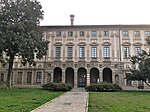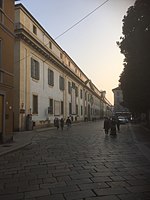Visconti Castle (Pavia)

The Visconti Castle of Pavia (Castello Visconteo di Pavia in Italian) is a medieval castle in Pavia, Lombardy, Northern Italy. It was built after 1360 in a few years by Galeazzo II Visconti, Lord of Milan, and used as a sovereign residence by him and his son Gian Galeazzo, first duke of Milan. Its wide dimensions induced Petrarch, who visited Pavia in the fall of 1365, to call it "an enormous palace in the citadel, a truly remarkable and costly structure". Adjacent to the castle, the Visconti created a vast walled park that reached the Certosa di Pavia, a Carthusian monastery founded in 1396 by the Visconti as well and located about 7 kilometres (4.3 mi) to the north.In the 16th century, an artillery attack on Pavia destroyed a wing and two towers of the castle. The frescos that entirely decorated the castle rooms are today almost completely lost. The castle had been the seat of the Visconti Library until its transfer to Paris in 1499. Today, it hosts the Pavia Civic Museums.
Excerpt from the Wikipedia article Visconti Castle (Pavia) (License: CC BY-SA 3.0, Authors, Images).Visconti Castle (Pavia)
Piazza Castello, Pavia Città Giardino
Geographical coordinates (GPS) Address Nearby Places Show on map
Geographical coordinates (GPS)
| Latitude | Longitude |
|---|---|
| N 45.19 ° | E 9.1583333333333 ° |
Address
Piazza Castello
27100 Pavia, Città Giardino
Lombardy, Italy
Open on Google Maps











